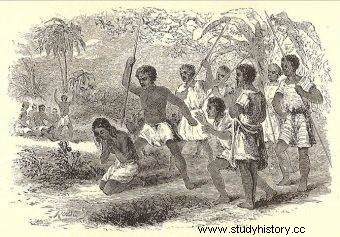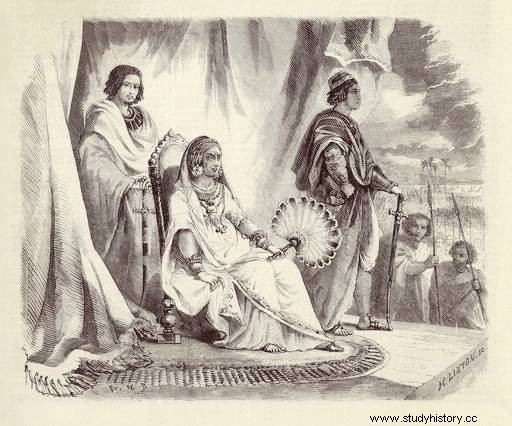Ranavalona I went down in history as the beast queen. Its bloody rule has reduced Madagascar's population by almost a third of its population. However, time was to show that her conservatism and drastic methods guaranteed the maintenance of power on the Great Red Island.
Ranavalona was the wife of Radama I, the ruler of Imerina in the years 1810–1828, one of the Madagascar countries that during his lifetime spread almost to the entire island. This expansion was possible mainly thanks to the alliances concluded by the Council with France and Great Britain.
Under the treaties, the Great Red Island, as Madagascar is called, was visited, among others, by missionaries who, in addition to promoting the Christian religion, began to build schools and provide Western education for local children. The slave trade was also banned, which did not necessarily appeal to everyone as many courtiers and officers made a living by him.

Ranavalona I went down in history as the Beast Queen.
Despite this, Radama was regarded as a good strategist, whose rule contributed to the development of his rule. Unfortunately, his "antiphans" were not lacking in the high society, who did not enjoy the king's progressive reforms, which contributed to a drastic change in the style of governance after his death.
Ramada I died at the age of 37, possibly of syphilis or cirrhosis of the liver, both of which contributed to his rowdy lifestyle. Together with Ranavalona, who was 15 years her senior, they did not have any offspring. In this case - according to Imeryna's matriarchal principles - the throne belonged to the king's nephew, Rakotobe. However, it was not to the taste of the powerful who suspected that the heir would continue his uncle's reforms and his foreign policy. Therefore, a coup was brought about. His goal was to put on the throne of Imerina the 50-year-old widow of the king, whose conservative views reached a large part of the establishment.

Ramada I died at the age of 37, possibly of syphilis or cirrhosis of the liver, both of which contributed to his hectic lifestyle.
The lack of a descendant was also not a major problem for her, as "there was a rather strange tradition by which any child born to a widow after her husband's death was considered the rightful descendant of the deceased a spouse and had full right of inheritance ”. It was therefore hoped that the queen, despite her age, would still be able to give birth to a successor.
In 1828, a few days after Ramad I's death, a bloody coup took place. Many loyalists of the deceased ruler were killed, as well as his successor and the man's mother. The new queen had her thrown in prison and starved to death. Thus began the reign of Ranavalona I, soon to be called Cruel.
The reign of the bloody queen
Ranavalona began her reign by breaking alliances with France and Great Britain and lifting the ban on the slave trade. It also did not pursue a friendly policy for visiting Europeans, imposing taxes on them and making their lives so difficult that in the end most of them decided to leave the island.
All this displeased Imerina's former foreign allies, contributing to several attempts to invade Madagascar. Unfortunately, they failed , only affirming the new queen in her right to the throne, which she managed to secure by giving birth to an heir, Rakoto, a year after her husband's death. His father was probably one of the ruler's many lovers.
The queen's isolation policy focused primarily on her husband's former allies. Admittedly, she tried to renew the trade treaties with them, but on her own terms. This was not accepted, and Ranavalona had to consider how otherwise she could influence the country's development. It focused on industry, and more specifically the production of weapons, cannons and ammunition. In addition, it launched porcelain, rum, ink, silk and brick factories, and new trade agreements, including with American buyers, provided its sales markets.

Ranavalona began her reign by breaking alliances with France and Great Britain and lifting the ban on the slave trade.
Unfortunately, this did not improve the quality of life of the country's population. Slave labor, not only in factories, but also in the construction of the luxurious queen's palace in Antananarivo together with malaria epidemics and starvation, have resulted in the death of many thousands of people from exhaustion. However, this was not information that changed the behavior of the ruler in any way. On the contrary.
Feeling that nothing would stand in her way, Ranavalona decided to make "order" with the Christians. The Queen wanted to return to popular beliefs and eradicate the imported faith from Madagascar. She announced that the remaining missionaries on the island and other foreign citizens could believe what they liked, but that her subjects were to revert to the religion of their ancestors. It was not universally accepted as many of the inhabitants had practiced the Christian rite for a long time. This led to persecution that affected both the court and the common people.
Ranavalona dealt bloodily with dissenters, throwing them off the cliffs, hanging them, burning them, starving them and torturing them . All forms of Christianity were punished, from keeping a Bible at home to attending mass. In response to these events, the last missionaries left the island, closing established schools and cutting off local children from education. Despite this, the ruler did not manage to eradicate the "foreign" faith - her followers went underground.
New King
As the years passed, Ranavalona began to become paranoid. Fearing conspiracies on her life, she created a network of informers who had their ears and eyes everywhere and informed the queen of the slightest attempt to resist. They were immediately suppressed by executions or forced labor (and of which there was usually no return).
Tangen's trial was used in the testimony to reveal the real conspirators. The suspects were given a mixture of toxic herbs and three chicken skins . If the person who was subjected to this ritual returned the pieces, she was presumed innocent. It is estimated that about 3,000 people died under the influence of this torture during the rule of Ranavalona.

The population of Magadascar declined by a third during her rule.
The moods inside and outside the country were increasingly hostile to a cruel monarchy. Even her son made an attempt to overthrow his mother's rule. He failed because the queen, thanks to her network of informants, managed to put out the rebellion before it happened. And although she lost most of the people involved in the plot, she spared her son.
She ended her life in a dream in August 1861 at the age of 83. She sat on the throne for 33 years. While the exact numbers are unknown, researchers estimate that Magadascar's population decreased by a third during her rule.
The bloody rule of Ranavalona I Cruel was replaced by her son's policy of openness, who took the name of Radam II. With his accession to the throne, he reestablished cooperation with France and Great Britain. He also banned the slave trade and eventually converted to Christianity himself.
Interestingly, his reign might not have happened had it not been for the alliances his mother had meticulously made at the end of her life to ensure her son's power. On the day of his appointment, he had the support of all influential people in the country. Unfortunately, two years after his coronation, Radam II was killed in a coup by conservative officers who did not support his reformist agenda.
Bibliography
- Laidler, Caligula in a skirt. Madagascar's Mad Queen , Bellona, 2007.
- Staniul, Ranavalona - the cruel queen of Madagascar , wp.pl (accessed:7/03/2021).
- G.M. Berg, Writing Ideology:Ranavalona, The Ancestral Bureaucrat , Cambridge University Press, 2014.
